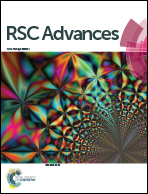Solvatochromism of a tricycloquinazoline based disk-shaped liquid crystal: a potential molecular probe for fluorescence imaging
Abstract
Tricycloquinazoline (TCQ) based discotic liquid crystals (DLCs) were found to be fluorescent in nature. Such molecules can be employed for the fluorescence imaging of another DLC. Therefore, it is essential to study systematically the photophysical properties of such molecules. In this article, we report the effect of solvents on the photophysical properties of DLC molecules possessing a central TCQ core covalently linked to 6 ethelenoxy side chains (TCQDL molecules). The solutions of TCQDL are prepared in organic solvents of different polarity. The solutions are scanned using ultraviolet-visible (UV-Vis) and fluorescence spectrophotometers. The excited state dipole moment of the TCQDL molecule is estimated from the data. The ground state dipole moment of the TCQDL molecule is calculated using Gaussian 03. We observed that the TCQDL molecule can be used as a fluorophore and used to image other non-fluorescent DLC systems. The epifluorescence imaging of the Langmuir monolayer of the pure TCQDL molecules at the air–water interface showed good image contrast allowing the identification of surface phases even in the absence of additive fluorescent probe molecules.



 Please wait while we load your content...
Please wait while we load your content...